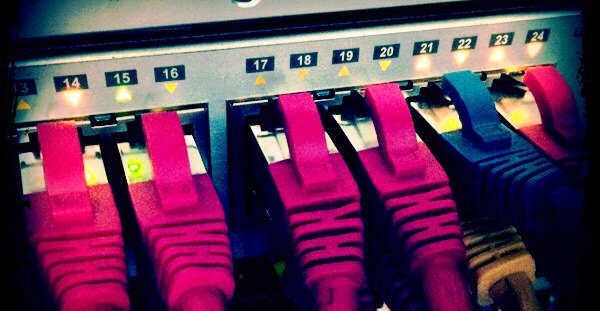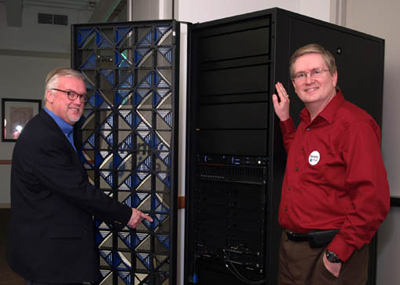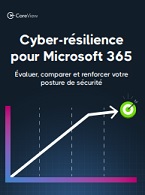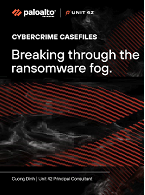En encapsulant le tout dans une fonction et en ajoutant la gestion des paramètres permettant la saisie du nom de la nouvelle machine, la sélection du système d'exploitation à déployer et la sélection de la configuration matérielle, on obtient le résultat suivant :
Le script final

Import-Module Hyper-V
Write-Host « Import VM Guest Library… »
$vm_path = « D:\Images Virtuelles »
function Add-VMGuest([string]$vm_name, [string]$vm_size, [string]$vm_operatingsystem)
{
switch ($vm_size)
{
‘S’ { $vm_processor = 2; $vm_mem_minimum = 512MB; $vm_mem_maximum = 1GB; $vm_disk_size = 60GB; break }
‘M’ { $vm_processor = 4; $vm_mem_minimum = 1GB; $vm_mem_maximum = 4GB; $vm_disk_size = 60GB; break }
‘L’ { $vm_processor = 8; $vm_mem_minimum = 1GB; $vm_mem_maximum = 6GB; $vm_disk_size = 60GB; break }
}
switch ($vm_operatingsystem)
{
‘Windows7’ { $vm_iso = « C:\Images ISO\Windows\Windows 7 SP1 (x64-EN).iso »; $vm_edition = « Ultimate »; $vm_unattended = « C:\ImagesVirtuelles\Unattend\Win7_ult_x64.xml »; break }
‘Windows8’ { $vm_iso = « C:\Images ISO\Windows\Windows 8 Enterprise Trial 90d (x64-EN).iso »; $vm_edition = « Enterprise »; $vm_unattended = « C:\ImagesVirtuelles\Unattend\Win8_ent_x64.xml »; break }
‘Windows8.1’ { $vm_iso = « C:\Images ISO\Windows\Windows 8.1 Enterprise Technet (x64-EN).iso »; $vm_edition = « Enterprise »; $vm_unattended = « C:\ImagesVirtuelles\Unattend\Win8.1_ent_x64.xml »; break }
‘Windows2008R2’ { $vm_iso = « C:\Images ISO\Windows Server\Windows Server 2008 R2 SP1 (x64-EN).iso »; $vm_edition = « ServerEnterprise »; $vm_unattended = « C:\ImagesVirtuelles\Unattend\Win2008r2_x64.xml »; break }
‘Windows2012’ { $vm_iso = « C:\Images ISO\Windows Server\Windows Server 2012 Trial (x64-EN).iso »; $vm_edition = « ServerDataCenterEval »; $vm_unattended = « C:\ImagesVirtuelles\Unattend\Win2012_x64.xml »; break }
}
#Création de la VHD
New-Item « $vm_path\$vm_name\ » -ItemType Directory
C:\ImagesVirtuelles\Library\Convert-WindowsImage.ps1 -SourcePath $vm_iso -Edition $vm_edition -VHDPath « $vm_path\$vm_name\$vm_name.vhdx » -VHDFormat VHDX -VHDType Dynamic -SizeBytes $vm_disk_size -UnattendPath $vm_unattended
#Ajout du Kit d’outils AVAEDOS
$vkit_path = ‘C:\VirtualKit\AVAEDOS’
$vhd_path = Mount-VHD -Path « $vm_path\$vm_name\$vm_name.vhdx » -Passthru -NoDriveLetter
$vhd_path | Get-Disk | Get-Partition | Where-Object -Property PartitionNumber -eq -Value 1 | Set-Partition -NewDriveLetter M
Remove-Item M:\AVAEDOS -Confirm:$False -Force -Recurse
Copy-Item $vkit_path -Destination M:\ -Recurse -Verbose
$vhd_path | Dismount-VHD
New-VM –Name $vm_name -Path $vm_path –MemoryStartupBytes 1GB –VHDPath « $vm_path\$vm_name\$vm_name.vhdx » -SwitchName « AVAEDOS Network »
Set-VM -Name $vm_name -ProcessorCount $vm_processor -DynamicMemory -MemoryMinimumBytes $vm_mem_minimum -MemoryMaximumBytes $vm_mem_maximum -AutomaticStartAction Nothing
Start-VM -VMName $vm_name
}
Ce script peut ensuite être automatiquement déployé à chaque lancement de votre environnement PowerShell en ajoutant la ligne suivante dans votre fichier de profil (C:\Users\<utilisateur>\Documents\WindowsPowerShell\profile.ps1):
Import-Module C:\ImagesVirtuelles\Library\Script.ps1
A chaque lancement de l’environnement PowerShell en activant les privilèges administratifs, vous pourrez déployer tout un environnement simplement à l’aide des commandes suivantes par exemple :
Add-VMGuest AD-DC1 S Windows2012
Add-VMGuest EXCH-MBX1 L Windows2012
Add-VMGuest EXCH-MBX2 L Windows2012
Add-VMGuest EXCH-EDGE M Windows2008
Add-VMGuest CLI-WIN1 S Windows8.1
Téléchargez cette ressource

Comment accélérer la transformation des environnements de travail ?
Dans un monde professionnel en pleine mutation, la mobilité, l’efficacité énergétique, la sécurité et l’intelligence embarquée sont devenues des critères décisifs pour les équipements informatiques. Découvrez comment les nouveaux PC Microsoft Surface dotés des processeurs Snapdragon X Series s’imposent comme une réponse stratégique aux nouveaux enjeux IT.
Les articles les plus consultés
Les plus consultés sur iTPro.fr
- DSI en assurance : gardien du temple ou moteur de la transformation ?
- Ransomware : persistance des cyberattaques à l’échelle mondiale
- Cybersécurité : l’IA générative rebat les cartes du cybercrime
- Le World Cyber Ranking, 1er classement mondial de la cybersécurité des entreprises
- Comment le Quarter Plan permet d’aligner IT et Métiers pour délivrer










